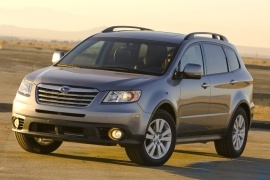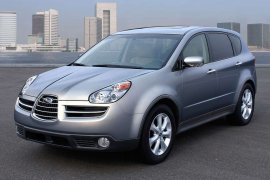SUBARU Tribeca Models/Series Timeline, Specifications & Photos
First production year: 2005
Engines: Gasoline
Body style: SUV (Sports Utility Vehicle)
Subaru refreshed the first generation of the Tribeca crossover just two years after introducing this nameplate in its inventory and tried to fix what caused customers to avoid it: its design.
The Japanese automaker was known for producing some excellent cars, but while it threw a lot of money into its engineering department, it looked like it paid its designers with lunch money. Examples such as the Subaru XT or the Impreza "Bugeye" are just a few examples of failed design. Still, none of them failed so spectacularly in the eyes of its fans as the Tribeca's first generation. As a result, the Japanese automaker rushed a facelift into production, and at the 2007 New York Auto Show, it brought the enhanced version, which was a much better product.
At the front, the car lost the unusual-looking headlights with three headlamps inside them. The automaker also replaced the three-element grille that it said should resemble an aircraft with a more traditional wide one crossed by three horizontal slats and a fourth, chromed one on top of it. On the lower side of the bumper, the automaker left a black unpainted area that was scratch-resistant and installed a pair of round fog lamps that flanked a split air intake. As a result, the vehicle's overall look was more conservative but more pleasant to many customers.
The 2005 Tribeca had a nice-looking profile, and Subaru understood that it had to keep it or slightly improve it, which it did. While it kept the same ascending beltline with the longitudinal crease that emerged from the front doors to the rear quarter panels, it redesigned the rearmost set of windows, enlarging them at their lower side. That detail improved the rear three-quarter driver's visibility, which was appreciated. Finally, at the back, the 2007 Tribeca received a new set of taillights, which were bigger than those from the 2005 model year.
Inside, the dashboard's design was greatly improved. While the instrument cluster kept the binocular style for the speedometer and tachometer, the coolant temperature and fuel level gauges that flanked it didn't look like they were placed there at the last minute before production. The waved-shaped dashboard design was more pleasant and featured a silver trim on the center stack and the center console. Like the 2005 model year, the 2007 Tribeca used the same three-row seating layout. While there was enough room for two passengers in the rearmost seats, access to those was difficult. Still, thanks to the sliding second row, it was good enough for children and less-than-average-height adults.
Subaru also improved the engine for the 2007 Tribeca. By enlarging the bore and lengthening the pistons' strokes, the new 3.6-liter powerplant produced more power and torque. Moreover, the improved transmission saved some weight. As a result, the revised version of the Tribeca gained almost one second for the 0-62 mph (0-100 kph) run and gained 7 mph (10 kph) in top speed.
Subaru was known for its all-wheel drive vehicles and tried its luck with a larger vehicle known as Tribeca, which it launched in 2005 at the North American International Auto Show.
While Subaru vehicles were often praised for their all-wheel drive abilities, only a few of them were appreciated for their look, and the 2005 Tribeca was just the case. Nevertheless, in terms of practicality, it was a great crossover that followed the automaker’s engine/transmission setup guidelines. In addition, adding a three-row seating inside a cabin that was large enough to make everybody feel comfortable was appreciated. But customers needed more than just a great engine/transmission combo. Besides, the fuel efficiency of the 2005 Tribeca was far from being considered economic.
Arguably, the car’s front fascia was the one that made most people raise their eyebrows. Subaru said that the center trapezoidal shape flanked by horizontal grilles resembled the carmaker’s origins in the aviation industry, but that was not exactly what Subaru’s customers expected. In addition, the triangular headlights with three individual lamps inside them made the Tribeca’s front fascia look even more intriguing, but not in a pleasant way.
From its sides, the rounded shapes of the bodywork were pleasant. It featured an ascending beltline and a crease that started on the front doors and ran towards the back of the car, over the rear doors and quarter panels. The blackened B-posts and the up-kick on the rearmost set of windows were appreciated. Furthermore, the roof spoiler placed atop the rear window from the raked-forward tailgate resembled the image of a hot hatch. Underneath the rear bumper, the Tribeca boasted a set of side-mounted exhausts that gave the car an even sportier look.
Inside, Subaru’s designers made a binocular-styled instrument cluster where the tachometer took the left dial, and the speedometer took the right one. The coolant temperature and the fuel level gauges looked like they were added afterward when the designers realized that they had missed them. In addition, depending on the grades, Subaru installed an infotainment screen atop the center stack in the middle of the dashboard. The driver and the side passenger were separated by a wide center console that housed the transmission lever and two cup holders covered by a split-opening cap. On the middle row, two passengers could sit comfortably, while a third middle-seated one should find a way to avoid the tall transmission tunnel. Finally, the rearmost seats were suitable only for children.
Subaru made the Tribeca on the same platform as the Outback, although it was slightly longer than that. The only engine version available was a three-liter flat-six naturally aspirated engine paired with a five-speed automatic transmission. Power went in all corners via a symmetrical all-wheel drive system developed by the automaker.

